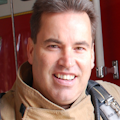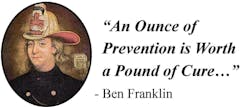This October, Fire Prevention Week entered its centennial year. As in every anniversary, it’s time to remember, honor, and take stock on where the current day finds us; after all, the fire service’s roots, and much of community development, sprouted from fire prevention. From Benjamin Franklin’s famous quote, “An ounce of prevention is worth a pound of cure,” referencing the carrying of hot coals through wooden homes with shovels, to today’s building and community building and development codes, the prevention of fire is on every page.
Philosopher Georges wrote in 1905, “Those who cannot remember the past are condemned to repeat it,” and as we move throughout life’s journey, we undoubtably have found this to be true, no matter what aspect of life we apply it to. Today, fires are still starting and spreading the same as it did when cavemen first discovered it, and more alarmingly, it’s exploding and killing more efficiently today than it ever has. Learning this history, and how we got here, I believe is just as important for our recruits and future firefighters to know and learn as any firefighting topic found between the pages of any firefighting manual. Such knowledge is a true base from which to grow their career and carry the fire service into the 21st century. Just as NIOSH LODD reports provide the “why” on many of today’s fireground and training approaches, because we’ve studied and learned them, so does knowing how the 1903 Iroquois theater fire, the 1942 Coconut Grove fire, the 1977 Beverly Hills Supper Club fire, and the 2003 Station Night Club fire are connected, and how it killed hundreds of the very citizens we are sworn to protect from such a death, and the SIMPLE things we can do to prevent it.
It's impossible in one article to fully explore and discuss all that has occurred in fire prevention over the last 100 years. What I would like to do is provide a brief overview of the good, the bad, and the ugly to see where we have done well, what we have not done so well, and what we still need to change.
The good!
Over the last century, overall, fire deaths are down. In 1925, according to Calvin Coolidge, the 30th President of the United States, who expanded Fire Prevention Day into Fire Prevention Week, 15,000 Americans died in fire in 1924, and that number was set to be surpassed in 1925. By the 1973 America Burning Report, the number of fire deaths had declined to 12,000 annually, and according to the latest NFPA report, Fire Loss in the United States in 2020, the number of fire deaths were reported to be 3,500. So, over the last century, fire deaths have been reduced by 77 percent.
What was once a task conducted by one or two personnel, many times those on light duty or preparing to retire, fire prevention has not only professionalized, its progressed beyond fire. Fire prevention activities, along with those who carry them out, are now guided by professional standards from the NFPA. What was once just fire prevention has now expanded to Community Risk Reduction (CRR), which encompasses all community hazards and injuries, and is largely carried out by trained and professional inspectors and educators. The expansion into CRR, I believe, has also help push today’s fire service out of a primary response role, and into a profession that contributes daily to the overall health and safety of its citizens, which increases a fire department’s daily value, and is something today’s society expects from modern government services.
CRR is expanding the field of prevention and starting to connect the prevention world with the operational world. The data provided by CRR not only helps indicate where the most hazardous risks are, but also helps justify staffing and resource allotment. The data, called a Community Risk Analysis, also helps keep programs on track to produce the best results. Gone are the days when firefighters taught Stop-Drop-Roll “just because,” but programs today are laser focused on the root causes of risks, and CRR provides methods to monitor your department’s efforts to ensure that are producing results. Today there are classes and conferences specifically for CRR, and material readily available for any educator or line firefighter to pick up and put to use.
The bad!
CRR, and traditional prevention, continues to be understaffed, underfunded, and underused in many departments across the U.S. Many times, CRR is used more as a public relations tool whose offices lie outside the operational divisions of the department in an “us” verses “them” atmosphere. When budgets become tight, CRR and prevention offices are the first to take the hit, even though by increasing funding and resources to this effort, over time, will reduce costs and save budgets as proven by other countries who have embraced this concept.
We are still not changing the fire service culture when it comes to CRR or prevention. Many line firefighters, who wear a badge symbolizing the protection of life and property, still do not embrace CRR or prevention as their responsibility let alone a core duty. CRR topics are located in chapter 22 (out of 27) of the IFSTA Essentials of Firefighting 7th Edition textbook, meaning most recruits will not receive instruction on CRR until the end of their training, and will probably receive no continual training on this topic back at their departments. In order to receive IFSAC or Pro Board certification as a basic fire officer, you are required have a basic fire instructor certification, but no requirement for public education certifications or training. In the IFSTA Company Officer 6th Edition textbook, there are no chapters for prevention or CRR with the exception of chapter 10 (out of 16) dealing with fire inspections and pre-incident planning. While inspections and preplanning are CRR activities, there is no information teaching new officers how to lead a CRR or prevention program or lead and mentor junior firefighters on the same.
So, what that means in summary, is that our newest members who are the future of the fire service, receive only a brief instruction on CRR as part of their basic training, and when they promote to an officer, CRR leadership is not part of the curriculum. This is why most new recruits can recite the gpms of various hoses and nozzles, but cannot answer a basic question on the gpms of a sprinkler head, even though sprinkler systems are the most efficient way to protect life and property from fire, as well as ensuring “Everyone Goes Home,” which are two major mantras of the fire service.
The ugly!
While fire deaths over the last century have been reduce by 77 percent, there has only been a 42 percent reduction in fire deaths from 1980 to 2020, keeping in mind that there are fire departments who are not reporting their statistics to NIFRS. This less than modest decline over four decades is alarming considering the explosion of knowledge and technology during that same time period. Adding to this, according to the NFPA 2020 Fire Loss Report, the fire death rate of 7.2 per 1,000 fires is nearly identical to the 7.1 deaths in 1980; meaning, while overall fires may be down, more people are dying in them. NFPA also states in this report, that “the rate for one- and two-family home fires was 16 percent higher than in 1980.” (*Ahrens, Evarts, 2021)
While in existence since 1812, we are still building structures without sprinkler systems, and firefighters and civilians are still dying in those structures, to say nothing of firefighters now dying from occupational exposures from fires allowed to grow and produce toxins. Sprinkler systems are the fire service’s equivalent to the medical profession’s cure for cancer, and could all but eradicate fires and fire deaths, yet many line firefighters, who are in contact with the public daily, are largely uneducated on this effective cure.
In all categories, the good, bad, or ugly, much more can be added, and as stated previously, well beyond one article. This was simply a bird’s-eye view to give some thought to in order to honor this important anniversary.
A final thought. In 1978, a high of 173 firefighters died in the line of duty. In 2004, the Everyone Goes Home (EGH) program began, which is a nationally driven program centering around firefighter safety. In the 26 years from 1978 to 2004 firefighter deaths dropped 34 percent; however, in the 16 years since the start of EGH program, firefighter deaths dropped 47 percent. So, what this means is, when firefighters are motivated, supported, and driven, results are produced, and lives are saved.
In 2004, when EGH kicked off, 106 firefighters had died in the line of duty, and 3,900 civilians died in fire. In 2020, 56 firefighters died in the line of duty, and 3,500 civilians died in fire.
Any maybe that is the biggest lesson to learn from the last 100 years.
(Note: Firefighter deaths in the years 2001 and 2021 were not considered, not to disrespect those who died in those years, but the increased numbers were largely due to the unpresented events of 9/11 and COVID-19.)
*Ahrens, M., & Evarts, B. (2021). (rep.). Fire Loss in the United States During 2020. Quincy, Ma: NFPA.
About the Author

Daniel Byrne
DANIEL BYRNE is a community support officer for the Burton Fire District, Beaufort County, SC, and a retired assistant fire chief of training for the Georgia Air National Guard 165th Fire Department. A third-generation firefighter, he holds an associate degree and a bachelor’s degree in fire science as well as a master’s degree in public administration and disaster management. Byrne is an alumnus of the National Fire Academy. He received state and local awards for public relations and educational programs as well as community partnerships and served as a conference presenter and keynote speaker.
